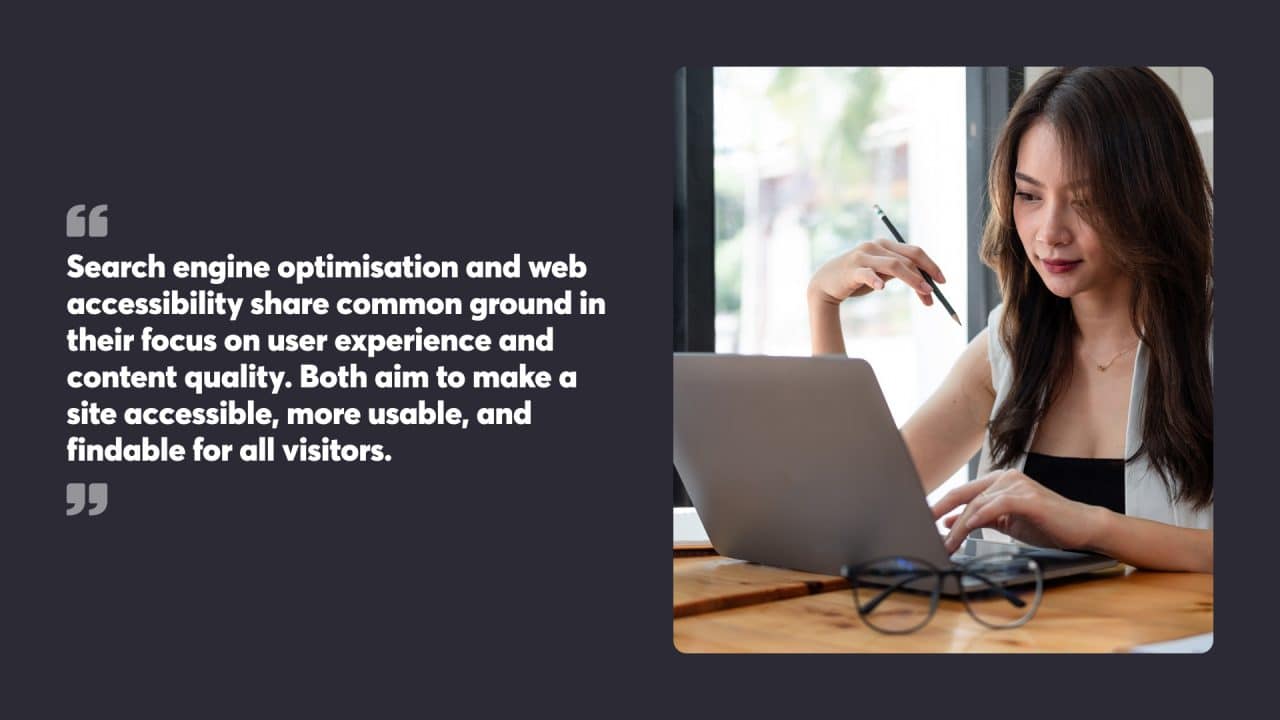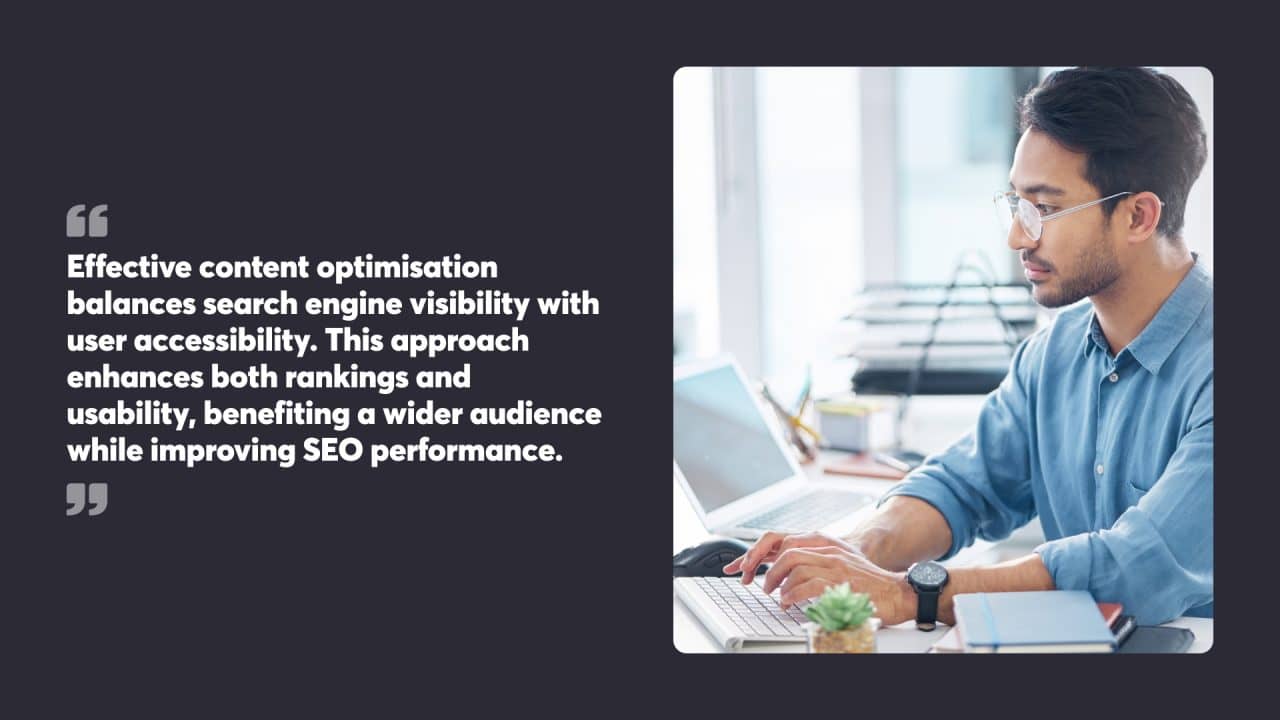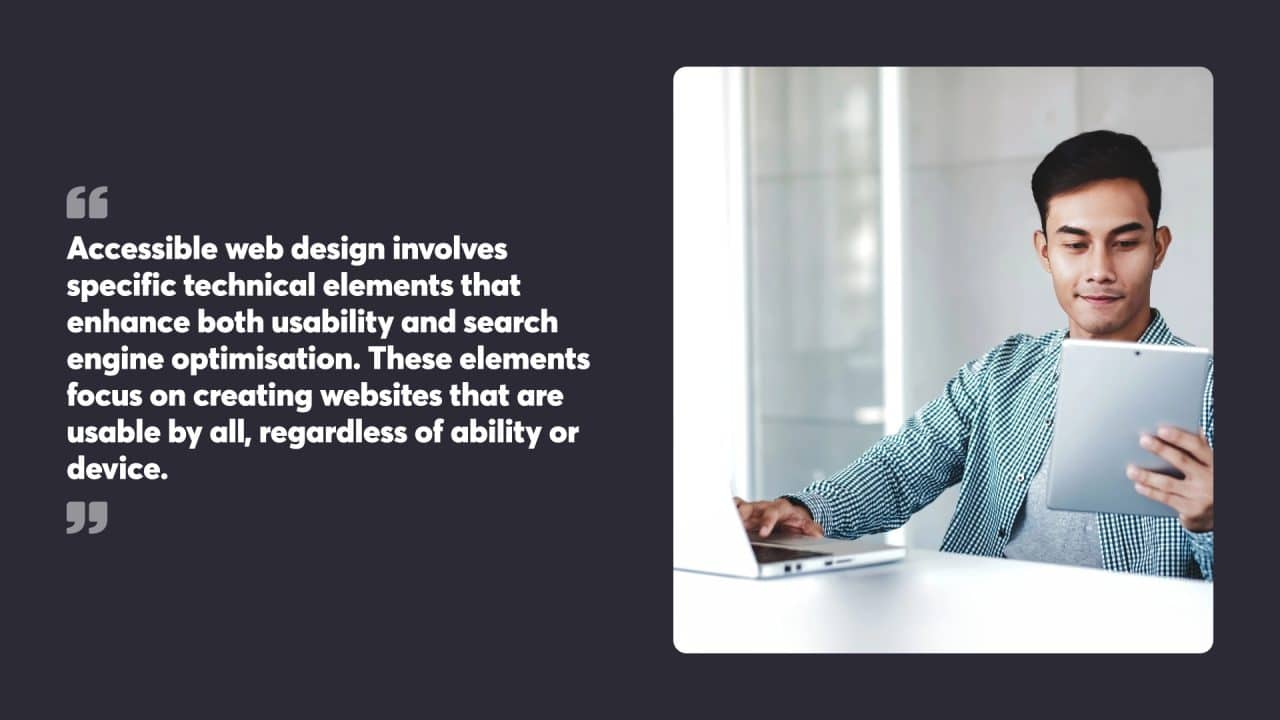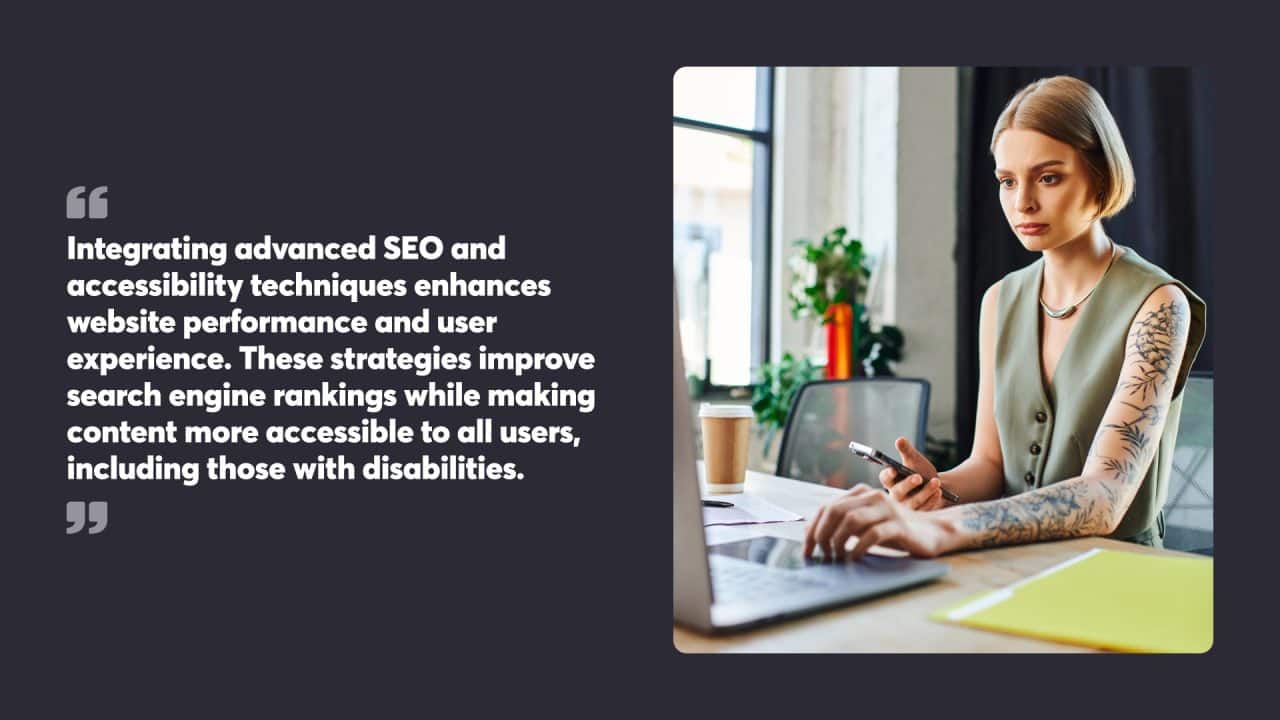
Web accessibility and SEO share a symbiotic relationship, both aiming to enhance user experience and website visibility. When websites are designed with accessibility in mind, they often naturally align with SEO best practices. Accessible websites typically have clearer structure, better navigation, and more descriptive content, which search engines value highly.
Optimising for both accessibility and SEO involves similar techniques. Alt text for images, proper heading structures, and clear navigation not only help users with disabilities but also assist search engines in understanding and ranking web pages. These elements contribute to a more user-friendly site that search engine algorithms tend to favour.
By focusing on accessibility, website owners can inadvertently improve their SEO performance. Features like transcripts for audio content and descriptive link text serve dual purposes, making sites more inclusive while providing additional context for search engines to analyse and index.
Key Takeaways
- Web accessibility and SEO share common goals and techniques, with accessible design often aligning with search engine preferences. By focusing on accessibility features like clear site structure, descriptive alt text, and semantic HTML, websites can inadvertently improve their SEO performance while creating a more inclusive user experience.
- Accessible content is typically easier for search engines to crawl and index effectively. Proper heading structure, descriptive link text, and multimedia elements with captions and transcripts not only help users with disabilities but also provide additional context for search algorithms to understand and rank the content better in search engine results pages.
- Advanced techniques like semantic HTML and off-page optimisation further enhance the symbiotic relationship between accessibility and SEO. ARIA attributes, fast loading speeds, and responsive design contribute to improved user experience across all devices while meeting search engine requirements for well-structured, mobile-friendly websites that cater to a diverse audience.

Table of Contents
Fundamentals of SEO and Web Accessibility
Search engine optimisation and web accessibility share common ground in their focus on user experience and content quality. Both aim to make a site accessible, more usable, and findable for all visitors.
Definition and Importance of Web Accessibility
Web accessibility refers to the practice of designing and developing websites that are inclusive and accessible to all users, regardless of their abilities or disabilities. This includes individuals with visual, auditory, cognitive, or motor impairments. The importance of web accessibility lies in its ability to provide equal access to information and opportunities for people with disabilities, promoting digital inclusion and social equality.
By ensuring that websites are accessible, businesses can create a more inclusive online environment, allowing everyone to engage with their content and services. This not only enhances the user experience but also aligns with ethical standards and legal requirements, fostering a more equitable digital landscape.
Benefits of Web Accessibility
Web accessibility offers numerous benefits that extend beyond compliance and inclusivity.
Firstly, it significantly improves user experience by ensuring that all users, regardless of their abilities, can navigate and interact with the website effortlessly. This leads to higher user satisfaction and engagement.
Secondly, accessible websites are more likely to appear in search engine results, as search engines like Google prioritise sites that are user-friendly and accessible. This increased visibility can drive more organic traffic to the site. Additionally, businesses that prioritise web accessibility demonstrate their commitment to inclusivity and social responsibility, which can enhance their brand reputation and attract customers who value these principles.
Lastly, compliance with web accessibility regulations is a legal requirement in many countries, and businesses that fail to meet these standards may face legal consequences. By adhering to accessibility guidelines, businesses can avoid potential legal issues and ensure their website is accessible to all users.
Core Principles of Accessibility
Web accessibility centres on four key principles: perceivable, operable, understandable, and robust. Perceivable content can be seen or heard by all users, including those with visual or auditory impairments. Operable websites allow navigation and interaction through various input methods, such as keyboard or voice commands. Understandable content uses clear language and logical structure. Robust websites work across different browsers and assistive technologies.
Implementing these principles involves using proper HTML structure, adding alt text to images, and creating keyboard-friendly navigation. These practices benefit all users and align with search engine requirements for well-structured content.
Essential SEO Best Practices
SEO best practices focus on improving a website’s visibility in search engine results. Key strategies include keyword research and optimisation, creating high-quality content, and building a strong link profile. On-page SEO involves optimising title tags, meta descriptions, and header tags to accurately describe page content.
Technical SEO aspects like site speed, mobile-friendliness, and secure connections (HTTPS) are vital for both search rankings and user experience. Content should be original, informative, and regularly updated to meet user needs and search engine expectations. These practices often overlap with accessibility guidelines, creating a synergy between SEO and web accessibility efforts.

Understanding Search Engine Mechanics
Search engines employ complex algorithms to index, rank, and display web content. These systems aim to provide users with the most relevant and useful results for their queries.
How Search Engines Index Content
Search engine crawlers, also known as spiders or bots, systematically browse the web to discover and catalogue pages. They follow links between pages, creating a map of the internet. When crawlers find new or updated content, they add it to the search engine’s index.
Crawlers analyse various elements of a webpage, including:
- Text content
- HTML structure
- Metadata (title tags, meta descriptions)
- Images and alt text
- Inbound and outbound links
The indexing process allows search engines to quickly retrieve relevant results when users perform searches. Well-structured, accessible websites tend to be easier for crawlers to navigate and index accurately.
Role of Accessibility in Search Algorithms
Accessibility features play a significant role in how search engines interpret and rank web content. Many accessibility best practices align with SEO principles, creating a symbiotic relationship between the two.
Key accessibility factors that influence search algorithms include:
- Proper heading structure (H1, H2, H3, etc.)
- Descriptive alt text for images
- Semantic HTML markup
- Clear and concise content
- Mobile responsiveness
Search engines favour websites that provide a positive user experience for all visitors, including those with disabilities. By implementing accessibility features, websites can improve their search engine rankings while also catering to a wider audience.

Optimising Content for Search Engines and Accessibility
Effective content optimisation balances search engine visibility with user accessibility. This approach enhances both rankings and usability, benefiting a wider audience while improving SEO performance.
Strategic Use of Keywords and Anchor Text
Incorporating relevant keywords into content helps search engines understand page topics. Placing keywords naturally within text maintains readability for users and avoids keyword stuffing. Descriptive anchor text for links provides context for both search engines and users, especially those using screen readers.
Keyword-rich headings organise content logically, aiding navigation for all users. This structure also allows search engines to better grasp page hierarchy and content relevance.
Alternative text for images serves dual purposes. It describes images for visually impaired users and provides additional keyword opportunities for search engines to index.
Crafting Accessible and SEO-Friendly Titles and Tags
Page titles play a crucial role in SEO and accessibility. They appear in search results and browser tabs, giving users a quick overview of page content. Titles should be concise, descriptive, and include primary keywords.
Meta descriptions, while not direct ranking factors, influence click-through rates from search results. Writing clear, compelling descriptions helps users decide whether to visit a page.
Header tags (H1, H2, etc.) structure content for both users and search engines. They break text into scannable sections, aiding comprehension for all readers, including those using assistive technologies.
URL structures should be clean and descriptive, incorporating relevant keywords where appropriate. This practice improves both SEO and user understanding of page content before clicking.
Image Optimisation for Search Engines
Image optimisation is a crucial aspect of search engine optimization (SEO) that involves making images search engine-friendly. This process includes several key practices. Firstly, using descriptive alt text provides a textual description of an image, allowing search engines to understand the content and improving its visibility in search results. Secondly, relevant file names should be used, incorporating keywords to help search engines understand the image’s context.
Compressing images is also essential, as it reduces file size, improves page load times, and enhances user experience. Lastly, using schema markup provides additional context about an image, helping search engines understand its content and relevance. By following these practices, businesses can ensure their images contribute positively to their overall SEO strategy.

Leveraging Accessibility for Enhanced SEO Performance
Web accessibility and SEO share a symbiotic relationship. By making websites more accessible, businesses can boost their search rankings and organic traffic.
Impact of Accessibility on Organic Traffic
Accessible websites attract a wider audience, including people with disabilities. This broader reach can lead to increased organic traffic and improved search rankings. Search engines favour sites that cater to all users, rewarding them with higher positions in search results.
Accessible content is often easier for search engines to crawl and index. Clear headings, descriptive alt text, and proper site structure help search engines understand and categorise content more effectively. This improved comprehension can result in better keyword rankings and increased visibility in search results.
Accessibility Features That Improve SEO
Several accessibility features directly contribute to better SEO performance. Alt text for images serves a dual purpose: it makes images accessible to screen readers and provides context for search engines. Proper heading structure (H1, H2, H3) improves both user navigation and search engine crawling.
Descriptive link text helps users and search engines understand where links lead. Instead of generic phrases like “click here”, using specific anchor text improves accessibility and SEO. Transcripts for audio and video content make media accessible to deaf users and provide text for search engines to index.
Responsive design, which adapts to different screen sizes, is essential for both accessibility and mobile SEO. Google’s mobile-first indexing prioritises mobile-friendly sites, aligning with accessibility best practices.

Technical Aspects of Accessible Web Design
Accessible web design involves specific technical elements that enhance both usability and search engine optimisation. These elements focus on creating websites that are usable by all, regardless of ability or device.
Mobile Responsiveness and Web Accessibility
Mobile responsiveness is critical for accessible web design. Websites should adapt seamlessly to different screen sizes and orientations. This involves using flexible layouts, scalable images, and appropriate font sizes. Touch targets for buttons and links must be large enough for users with motor impairments.
Responsive design also benefits SEO, as Google prioritises mobile-friendly sites in its rankings. Developers should test websites across various devices to identify and fix any accessibility issues. Features like pinch-to-zoom should be enabled to allow users to enlarge text and images as needed.
Accessible Architecture for Better SEO
Accessible web architecture improves both user experience and search engine rankings. Clear, semantic HTML structure helps screen readers interpret content correctly. Proper heading hierarchy (H1, H2, H3) organises information logically for all users and search engines.
Alt text for images serves dual purposes. It provides context for visually impaired users and helps search engines understand image content. Descriptive link text, instead of generic phrases like “click here”, aids navigation and SEO.
Site speed is another crucial factor. Optimising images, minifying code, and using caching can improve load times. This benefits users with slow internet connections and boosts SEO performance, as page speed is a ranking factor.

Aligning SEO Strategy with Accessibility Compliance
Integrating SEO practices with web accessibility standards benefits both search engines and users. This approach improves website visibility and usability for all visitors, including those with disabilities.
Accessibility Standards and SEO Alignment
Web Content Accessibility Guidelines (WCAG) set by the World Wide Web Consortium (W3C) provide a framework for creating accessible websites. Many WCAG principles align with SEO best practices. Alt text for images, for example, aids screen reader users and helps search engines understand image content. Clear, descriptive headings improve navigation for users and provide context for search engines.
Proper semantic HTML structure enhances both accessibility and SEO. Using appropriate heading tags (H1, H2, etc.) creates a logical content hierarchy. This structure helps users with assistive technologies and allows search engines to grasp page organisation.
Responsive design, a key accessibility feature, is also a Google ranking factor. Mobile-friendly websites cater to all users and perform well in search results.
Prioritising Both User Accessibility and SEO
A comprehensive approach to web design considers both accessibility and SEO from the start. This strategy creates a positive user experience for all visitors while improving search engine rankings.
Content creators should focus on producing clear, concise text that’s easy to understand. This practice benefits users with cognitive disabilities and aligns with SEO goals for readable, informative content.
Regular website audits can identify areas for improvement in both accessibility and SEO. Tools like Google’s Lighthouse can assess performance, accessibility, and SEO simultaneously.
Implementing accessible video content with captions and transcripts serves users who are deaf or hard of hearing. It also provides text for search engines to index, potentially boosting rankings for relevant queries.
Evaluating and Enhancing Existing Content
Assessing and optimising web content for accessibility can significantly boost SEO performance. This process involves thorough audits and strategic use of multimedia elements to reach a wider audience.
Accessibility Audits for SEO Improvement
Accessibility audits are crucial for identifying areas where websites can be enhanced for both users and search engine bots. These audits check for proper heading structure, alt text for images, and keyboard navigation. They also assess colour contrast and font sizes to improve readability. Fixing these issues not only helps users with disabilities but also makes content more crawlable for search engines.
Web developers can use automated tools and manual testing to find accessibility gaps. Addressing these gaps often leads to cleaner code and better-structured content, which search engines favour. For example, adding descriptive alt text to images helps screen readers and provides context for search engine bots, potentially improving image search rankings.
The Significance of Screen Reader Testing
Screen reader testing is a crucial aspect of web accessibility that involves evaluating websites with screen readers to identify potential accessibility barriers. Screen readers are software programs that read aloud the content of a website, enabling users with visual impairments to navigate and interact with the site.
Conducting screen reader testing helps businesses identify and fix accessibility issues, ensuring that their website is accessible to all users. This process is essential for creating an inclusive online environment and improving the overall user experience. By addressing the issues identified during screen reader testing, businesses can enhance their website’s accessibility, making it more usable for individuals with visual impairments and improving their search engine rankings.
Incorporating Multimedia for Wider Reach
Adding diverse multimedia elements can enhance accessibility and SEO performance. Video content, when properly optimised, can attract a broader audience and keep visitors on the site longer. This increased engagement signals to search engines that the content is valuable.
Captions and transcripts for videos serve multiple purposes. They make content accessible to deaf or hard-of-hearing users, and also provide text that search engines can index. Audio descriptions of visual elements in videos further improve accessibility and offer additional content for SEO. Infographics and interactive elements, when designed with accessibility in mind, can boost user experience and provide rich, engaging content that search engines appreciate.

Advanced Techniques in SEO and Accessibility
Integrating advanced SEO and accessibility techniques enhances website performance and user experience. These strategies improve search engine rankings while making content more accessible to all users, including those with disabilities.
Semantic HTML and its Impact on Accessibility
Semantic HTML plays a vital role in both SEO and accessibility. It provides structure and meaning to web content, making it easier for search engines and assistive technologies to interpret. Proper use of heading tags (H1, H2, H3) creates a logical hierarchy, aiding navigation for screen reader users and improving SEO rankings.
ARIA (Accessible Rich Internet Applications) attributes supplement HTML, providing additional context for assistive technologies. These attributes help describe complex interface components, enhancing accessibility without affecting visual presentation.
Descriptive alt text for images serves dual purposes. It allows visually impaired users to understand image content and provides context for search engines, potentially boosting SEO efforts.
Off-Page Elements and Their Influence
Off-page elements significantly impact SEO and accessibility. Optimising meta titles and descriptions improves search engine visibility and helps users with screen readers quickly grasp page content. These elements should be concise, relevant, and include target keywords.
Link building remains a powerful SEO strategy. High-quality, relevant backlinks signal content value to search engines. For accessibility, clear and descriptive anchor text helps users understand link destinations before clicking.
Site speed affects both SEO and accessibility. Fast-loading pages rank higher in search results and provide a better experience for all users, especially those with slower internet connections or older devices.
Mobile optimisation is critical. A responsive design adapts to different screen sizes, improving usability for all visitors and meeting Google’s mobile-first indexing requirements.

Implementing Web Accessibility and SEO Best Practices
Practical Steps to Improve Website Accessibility and SEO
Implementing web accessibility and SEO best practices requires a comprehensive approach that involves both technical and non-technical aspects. Here are some practical steps to improve website accessibility and SEO:
- Conduct an Accessibility Audit: Perform a thorough accessibility audit to identify potential barriers and areas for improvement. This involves checking for proper heading structure, alt text for images, and keyboard navigation.
- Implement Accessibility Fixes: Address the issues identified in the audit, such as fixing broken links, improving color contrast, and providing alternative text for images. These fixes enhance usability for all users and improve search engine rankings.
- Optimise for Speed: Improve website speed by compressing images, minifying CSS and JavaScript, and utilising browser caching. Faster load times benefit users and boost SEO performance.
- Focus on Content: Create high-quality, valuable content that is easy to understand and provides a clear call-to-action. This practice benefits users and aligns with SEO goals for readable, informative content.
- Mobile Optimisation: Ensure that the website is responsive and performs well on mobile devices. Mobile-friendliness is a key ranking factor, and responsive design improves usability for all visitors.
- Use Keyword-Rich Anchor Text: Use descriptive and keyword-rich anchor text for links to help search engines understand the content of the linked page. This practice enhances both accessibility and SEO.
- Follow Accessibility Guidelines: Adhere to web accessibility guidelines, such as the Web Content Accessibility Guidelines (WCAG), to ensure the website is accessible to all users. These guidelines provide a framework for creating inclusive digital experiences.
- Test with Screen Readers: Test the website with screen readers to identify potential accessibility barriers and ensure it is accessible to users with visual impairments. This step is crucial for creating an inclusive online environment.
By following these practical steps, businesses can enhance both their website’s accessibility and SEO performance, creating a more inclusive and visible online presence.
If you’re ready to improve your website design in a way that makes it more accessible and boosts your SEO efforts, contact us today.




